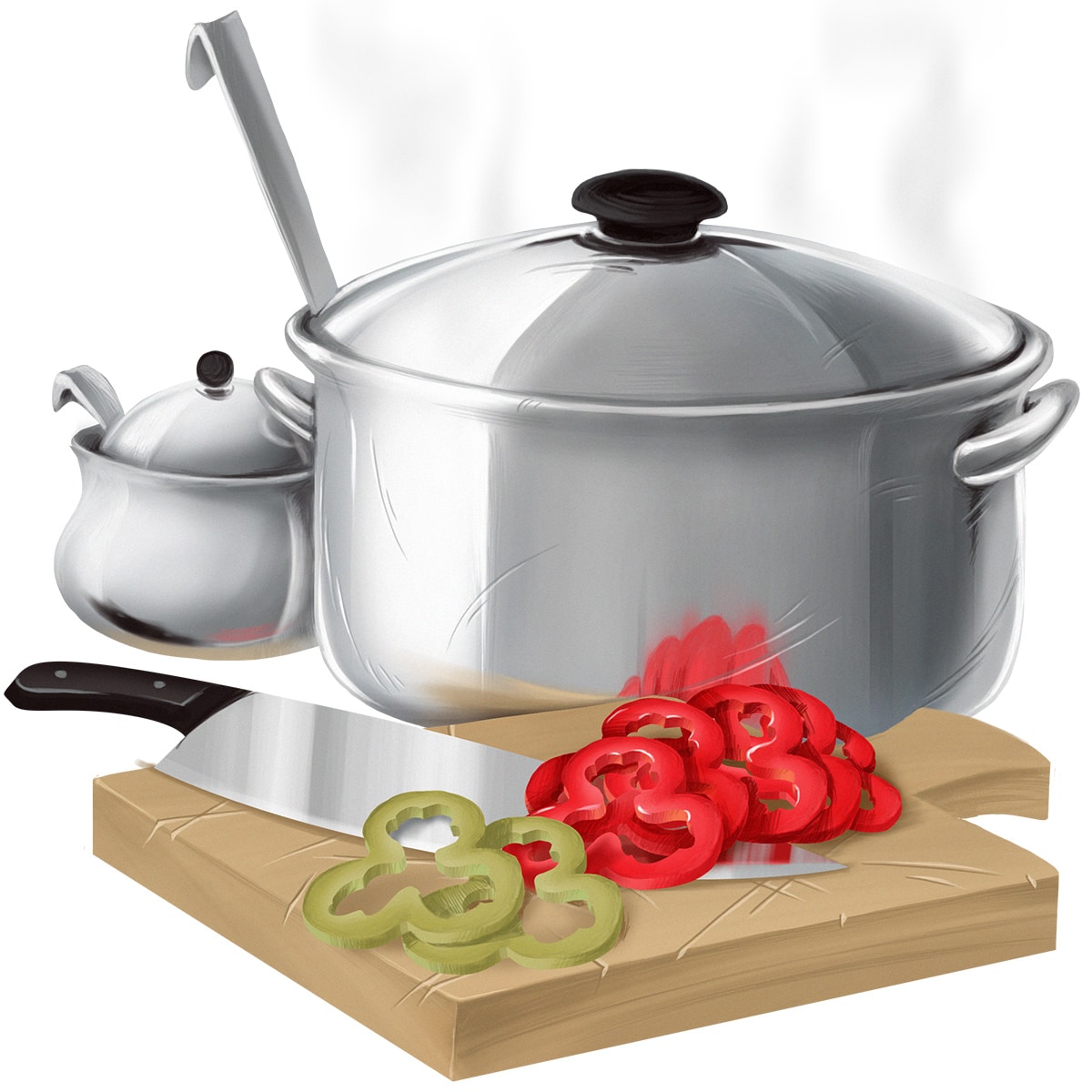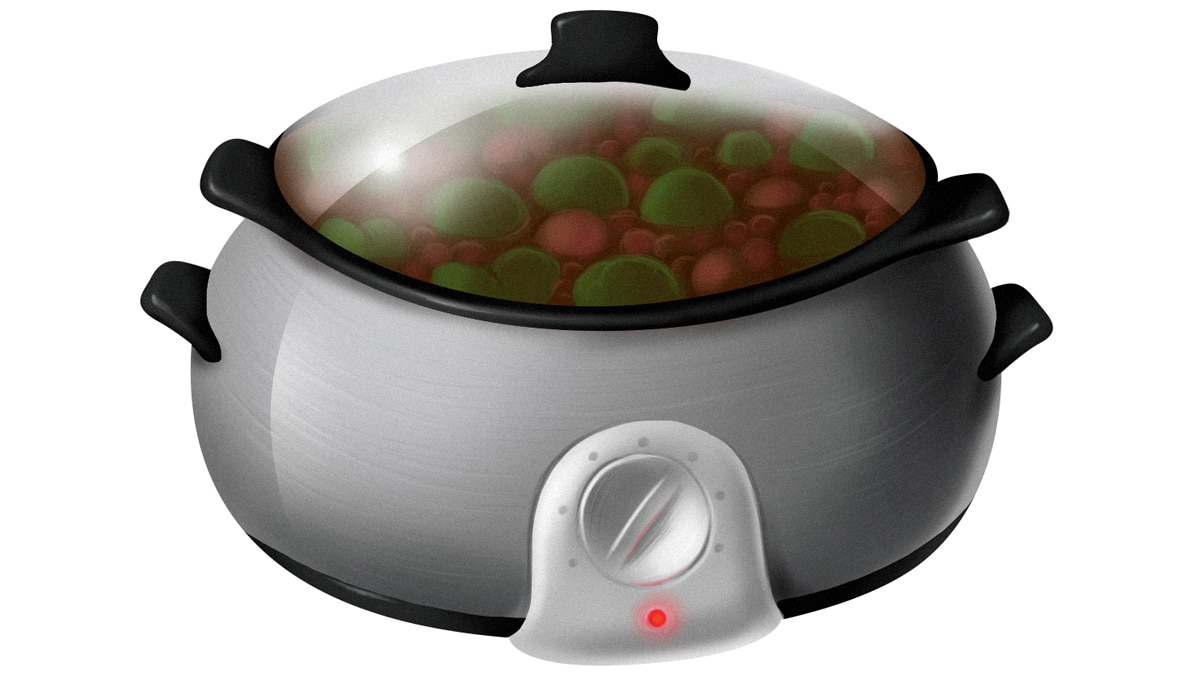Picture this: you’re standing at the kitchen counter, gazing fondly at the bright red stems and rich green-purple leaves of a fresh bunch of Swiss chard straight from the farmer’s market. You can practically still feel the warmth of the sunshine radiating up from your cutting board. You smile, thinking of all that nutritional goodness wrapped up in such a beautiful and tasty package.
But then the thought occurs to you: how shall I cook it? Will boiling or frying destroy the valuable phytonutrients? What about the microwave – am I irradiating my food into toxic nuclear goop? But on the other hand, if I eat it raw, what about the goitrogens? And juicing just concentrates the sugar! Help!
It’s tempting to rush to Google Scholar and drive yourself even crazier with the conflicting results of 20 different studies, but here’s the most important truth about cooking vegetables: the best way to cook them is the way you’ll actually eat them. If you want some new ideas for changing up your side dishes, or if you tend to rely exclusively on one cooking method only, read on for an analysis of all the different ways of getting your greens ready for your dinner plate. But at the end of the day, vegetables cooked using any method are better than no vegetables at all. And there’s a lot to be said for the method you find tastiest, whatever it might be.
Skip to a Cooking Method:
Raw vs. Cooked

Before even getting into the topic of how to cook vegetables, it’s important to touch on the subject of whether you should be cooking them at all. If any kind of cooking method destroys some of the nutrients, wouldn’t it be better to eat everything raw?
Cooking does destroy some nutrients, but it makes others much more bioavailable. For example, cooking reduces the levels of some antioxidants in broccoli, but increases others. It reduces the antioxidant content of kale, but increases it in tomatoes. A 2009 study of antioxidants found that each of the cooking methods tested decreased antioxidant levels in some vegetables but increased it in others.
Fat-soluble vitamins (A, D, E, and K) tend to hold up better than their water-soluble cousins (C and some B vitamins). Vitamin C tends to be the most unstable of all, and minerals are largely unaffected, since heating doesn’t affect mineral levels.
Notably, cooking also reduces the water content of a food, decreasing its overall volume. Fill a 2-cup measuring cup with spinach, then boil the spinach and measure it again: you can fit a lot more of the cooked version onto the same “plate space.” This means that even if the nutrient content is slightly less per gram of food, the number of total grams in your meal will probably be higher. So cooking your vegetables might actually help you consume more nutrients overall.
Cooking is also an effective way to destroy some antinutrients that might otherwise prevent the absorption of vitamins and minerals. For example, one study found that blanching (briefly dropping vegetables into boiling water and pulling them out as soon as they change color) significantly reduced the tannic acid and phytic acid of vegetables. And cooked vegetables can also be easier on the stomach, since the fiber content of raw vegetables sometimes makes them more difficult to digest, especially for high-FODMAPs foods.
Clearly, it’s a little more complicated than “cooking destroys nutrients; raw food is best.” It’s better to think of cooked vegetables and raw vegetables as two different but equally valuable additions to your plate, and eat a mix of both every day. As a general rule, cooking methods that minimize temperature, time, and liquid will maximize the nutrients in the vegetables themselves. But as the detailed breakdown of cooking methods shows, each method has its pros and cons.
Boiling
Overall, boiling is the most intensive cooking method around. It results in the greatest loss of everything, but that’s not actually all bad. For one thing, not all chemical compounds in plants are nutritious, and boiling is just as destructive to antinutrients as it is to everything else. Boiling is the best way to reduce the goitrogen content of cruciferous vegetables, like broccoli and kale. Goitrogens are a group of chemicals that aren’t dangerous at all for most people, but can make an existing thyroid disorder worse, so many people with thyroid symptoms try to avoid them. When you boil cruciferous vegetables, the goitrogens are not only destroyed by the heat, but also leached out into the water, a double whammy of antinutrient removal. Similarly, boiling is also most effective at reducing oxalates, a vegetable antinutrient that can contribute to kidney stones.
In some foods, boiling can even increase the nutrient content. In one 2008 study, carrots had higher concentrations of antioxidants after boiling than before, and boiling did a better job of preserving the nutrients than frying or steaming. Boiling also preserves Vitamin A better than frying, fermenting, or sun-drying.
Even though some nutrients are preserved, the downside of boiling vegetables is that if you drain the water, many of the vitamins (on average 10-25%) are lost along with the antinutrients. Unlike other cooking methods, boiling also reduces mineral content, not because the minerals are destroyed by the heat, but because they’re lost to the water. So for soups and stews, there’s nothing to worry about, but if you routinely boil vegetables you don’t intend to use in soup (like cauliflower for Paleo “rice”), you could be losing out.
Frying/sautéing
On the plus side, frying is an excellent way to get some fat in with your vegetables, making the fat-soluble vitamins more absorbable. There isn’t any water to drain off, so all you really have to worry about is the vitamins that can break down from the heat (C and B Vitamins). One study found that, since frying takes such a short time, it might actually be quite effective at retaining these vitamins: potatoes, for example, didn’t seem to lose any Vitamin C in the process of making them into French fries, and the fiber content actually increased thanks to the production of resistant starch.
One big drawback to frying is that unhealthy oils (like commercial deep-frying) turn an otherwise innocent vegetable into a vehicle for inflammatory junk fats and oxidative stress, especially if the oil has been re-used several times, as it always is in commercial foodservice operations. This is easily avoided, though; just use a Paleo cooking fat.
Roasting/baking
The good news about roasting is that it doesn’t require any added water, so the mineral content of the vegetables is entirely safe. And roasting also appears to be easy on the vitamins. One study found that roasting was a good way to preserve the B vitamins in various types of vegetables.
On the flip side, even though roasting is fairly gentle, some vitamins will inevitably be destroyed in the process. Critics of oven-roasting also point to the increased formation of AGEs (Advanced Glycation End-products, infamous for creating oxidative stress and accelerating the aging process), but since the AGEs your own body produces are far and away more significant than anything you get from your diet, it’s not clear how important this really is.
Slow-Cooking

Slow-cooking is a very gentle method, since it uses low temperatures compared to frying or boiling. There haven’t been a lot of studies on the nutrient content of vegetables prepared in a slow-cooker, but since the temperature is typically below the boiling point of water, it’s reasonable to assume that nutrient losses would be slightly less than for boiling.
On the other hand, like boiling, slow-cooking can leach minerals from the food if you don’t also eat the water. Realistically, soups and stews are what most people use slow-cookers for anyway (nobody makes a quick spinach side dish in a slow-cooker!), so it shouldn’t be a big problem. The other problem with slow cookers is that they expose the food to heat for a very long time, but this can usually be prevented by adding the vegetables in right at the end of the process: leave the meat in all day, come home at 5, add the vegetables, and sit down to dinner at 6.
Steaming
The favorite of the low-fat crowd, steaming is a very gentle cooking method, and doesn’t involve any water loss, which in general tends to maximize nutrient content. In one study, even the notoriously fragile Vitamin C in broccoli wasn’t degraded by steaming – and the total antioxidant content of the broccoli actually increased. For this reason, steaming is the method recommended by the World’s Healthiest Foods database as the best way to retain nutrients overall.
On the other hand, Paleo dieters know that low-fat food isn’t actually a benefit. Steaming doesn’t use any fat, so the fat-soluble vitamins in steamed vegetables won’t be as bioavailable. So toss your steamed vegetables with olive or coconut oil, or eat them alongside a big plate of fatty meat.
Microwaving
Microwaves allow for shorter cooking times, with less water than many other methods, maximizing nutrient content. For example, one study found that microwaving peppers did not reduce their polyphenol or Vitamin C content, while boiling did. Another study compared turnip greens blanched either in boiling water or in the microwave; the microwaved greens kept much more of their Vitamin C and various B vitamins. In the 2009 antioxidant study, microwaving was one of the best methods for consistently preserving antioxidant levels across all the vegetables tested. Levels of one kind of cancer-fighting chemical in red cabbage were actually increased after microwaving.
It’s also worth mentioning that frozen vegetables (the kind most people cook in microwaves) are usually picked at the peak of their freshness, so they may have more nutrients to begin with.
Interestingly, the vegetable that seems to be most negatively affected by microwave cooking is cauliflower, which loses over 50% of its antioxidant capacity. Another downside of microwaves is that they don’t always cook food evenly, they can get your vegetables unpleasantly dry, rubbery, or soggy, and they make it hard to cook meat and vegetables in the same pan. But as for the myth that microwave radiation somehow poisons your food or gives you cancer, there’s nothing to it.
Fermenting
It’s not technically a cooking method, since fermented food hasn’t been exposed to heat, but since it still changes the health profile of the vegetables, it’s worth a mention. The biggest upside to fermentation is the probiotic bacteria. These friendly additions to your kimchi or sauerkraut can help repopulate your gut flora and keep your entire digestive system humming along smoothly.
The probiotic benefits are great, but on the negative side, fermentation can dramatically raise the levels of histamines in a dish. If you’re not sensitive to histamines, this makes no difference whatsoever, but if you are sensitive, foods with high concentrations of histamines can cause the symptoms of an allergic reaction. And even the probiotic benefits might not be so great for someone suffering from a bacterial overgrowth (rather than a scarcity of bacteria), so fermented vegetables aren’t necessarily great for everyone.
Conclusion
You can go on forever dredging up different studies that prove one cooking method to be slightly superior to another regarding one specific antioxidant in one specific vegetable. But what this article should really show is that you can “prove” anything this way, and then “disprove” it by cherry-picking different studies. The moral of the story is that there is no “healthiest” cooking method; all of them have their upsides and downsides. Eat plenty of vegetables of every color; cook some of them, and have a salad once in a while. There are more important ways to improve your diet and health than stressing over whether or not you should boil your spinach.





Leave a Reply